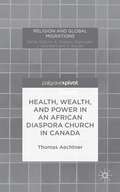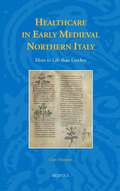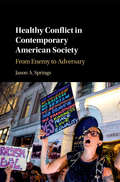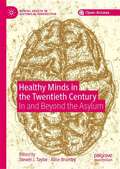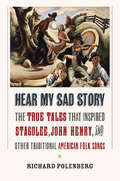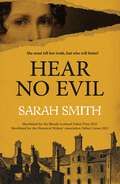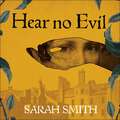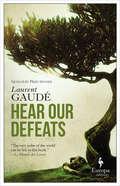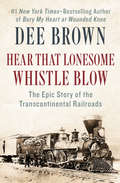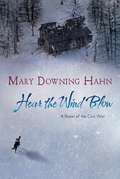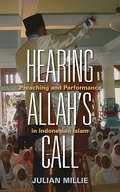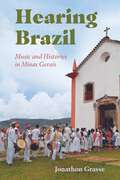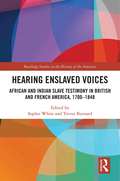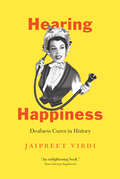- Table View
- List View
Health, Nutrition and Inequality in Latin America: An Anthropometric History (Routledge Explorations in Economic History)
by Manuel Llorca-Jaña José Miguel Martínez-Carrión Ricardo SalvatoreDrawing on anthropometric data, this book examines the evolution of biological living standards of Latin American populations and evaluates the inequality of nutrition and health in the region in the modern era.Utilising data from the 19th and 20th centuries, and providing broad coverage of Latin America, the chapters analyse the following topics: the evolution of stature before and after independence; the effects of economic modernisation since the 1870s and 1880s, that were accompanied by profound political, demographic, epidemiological and environmental changes that affected biological well-being of the population; the trend and evolution of anthropometric measures associated with nutritional, demographic and epidemiological transitions; the prevalence of malnutrition associated with stunting and obesity in traditional and modern societies, both rural and urban; the reduction or expansion of regional, social, income and educational differences in biological living standards as measured by mean heights; and the evolution of stature sexual dimorphism and the comparative importance of nutritional inequality by race and gender. The book highlights, on the one hand, the importance of anthropometric indicators to analyse living standards and human well-being in historical perspective and, on the other hand, the value of an interdisciplinary approach in examining questions of human growth and biological wellbeing.The book will be of great interest to readers in economic history, Latin American history and studies and the history of inequality and living standards.
Health, Sickness, Medicine and the Friars in the Thirteenth and Fourteenth Centuries (The History of Medicine in Context)
by Angela MontfordHealth, Sickness, Medicine and the Friars in the Thirteenth and Fourteenth Centuries explores the attitudes and responses of the mendicant orders to illness, their contribution to medical history, the influence of health and sickness as a factor in the orders' decision making, the extent of their participation in treatments, their relationship with physicians or their own involvement in medical practice, and the problems which occurred as a result of these matters. Apart from brief details of the last illness noted in some convent obituaries, the sick friar is usually conspicuous by his absence from the records. This book addresses this absence. By focusing on these neglected aspects of the mendicant orders it is possible to begin to reconstruct their attitudes and practices towards sickness, health and medical treatment. In so doing, a picture begins to emerge which provides a much fuller understanding of both mendicant and wider medical history. Through such an approach, the book demonstrates how preserving health as well as treating illness were matters of interrelated and vital concern to the friars, a concern that coincided with a rising interest in health matters in wider society during the thirteenth and fourteenth centuries.
Health, Wealth and Population in the Early Days of the Industrial Revolution
by M.C. BuerFirst Published in 2005. Routledge is an imprint of Taylor & Francis, an informa company.
Health, Wealth, and Power in an African Diaspora Church in Canada
by Thomas AechtnerThis book investigates an African diaspora Christian community in Calgary, Alberta, and explores the ways in which the church's beliefs and practices impact the lives of its migrant congregation. In particular, it reveals the church's pronounced concern with the utility of the Prosperity Gospel and Holy Spirit Power.
Healthcare In Early Medieval Northern Italy: More To Life Than Leeches (Studies In The Early Middle Ages #26)
by Clare PilsworthAfter the fall of the last Western Roman Emperor in 476 AD, Northern Italy played a crucial role - both geographically and culturally - in connecting East to West and North to South. Nowhere is this revealed more clearly than in the knowledge and practice of medicine. In sixth-century Ravenna, Greek medical texts were translated into Latin, and medical practitioners such as Anthimus, famous for his work on diet, also travelled from East to West. Despite Northern Italy's location as a confluence of cultures and values, modern scholarship has thus far ignored the extensive range of medical practices in existence throughout this region. This book aims to rectify this absence. It will draw upon both archaeological and written sources to argue for redefinitions of health and illness in relation to the Northern-Italian Middle Ages. This volume does not only put forward new classifications of illness and understandings of diet, but it also demonstrates the centrality of medicine to everyday life in Northern Italy. Using charter evidence and literary sources, the author expands our understanding of the literacy levels and social circles of the elite medical practitioners, the medici, and their lesser counterparts. This work marks a significant intervention into the field of medical studies in the early to high Middle Ages.
Healthcare in Latin America: History, Society, Culture
by David S. Dalton and Douglas J. WeatherfordIllustrating the diversity of disciplines that intersect within global health studies, Healthcare in Latin America is the first volume to gather research by many of the foremost scholars working on the topic and region in fields such as history, sociology, women’s studies, political science, and cultural studies. Through this unique eclectic approach, contributors explore the development and representation of public health in countries including Argentina, Bolivia, Brazil, Chile, Colombia, Cuba, Ecuador, El Salvador, Guatemala, Mexico, Nicaragua, Puerto Rico, and the United States. They examine how national governments, whether reactionary or revolutionary, have approached healthcare as a means to political legitimacy and popular support. Several essays contrast modern biomedicine-based treatment with Indigenous healing practices. Other topics include universal health coverage, childbirth, maternal care, forced sterilization, trans and disabled individuals’ access to care, intersexuality, and healthcare disparities, many of which are discussed through depictions in films and literature. As economic and political conditions have shifted amid modernization efforts, independence movements, migrations, and continued inequities, so have the policies and practices of healthcare also developed and changed. This book offers a rich overview of how the stories of healthcare in Latin America are intertwined with the region’s political, historical, and cultural identities.Contributors: Benny J. Andrés, Jr. | Javier Barroso | Katherine E. Bliss | Eric D. Carter | David S. Dalton | Carlos S. Dimas | Sophie Esch | Renata Forste | David L. García León | Javier E. García León | Jethro Hernández Berrones | Katherine Hirschfeld | Emily J. Kirk | Gabriela León-Pérez | Manuel F. Medina | Christopher D. Mellinger | Alicia Z. Miklos | Nicole L. Pacino | Douglas J. Weatherford Publication of this work made possible by a Sustaining the Humanities through the American Rescue Plan grant from the National Endowment for the Humanities.
Healthcare in Private and Public from the Early Modern Period to 2000: From The Early Modern Period To 2000
by Paul WeindlingA key volume on a central aspect of the history of medicine and its social relations, The History of Healthcare in Public and Private examines how the modernisation of healthcare resulted in a wide variety of changing social arrangements in both public and private spheres. This book considers a comprehensive range of topics ranging from children's health, mental disorders and the influence of pharmaceutical companies to the systems of twentieth century healthcare in Britain, Eastern Europe and South Africa. Covering a broad chronological, thematic and global scope, chapters discuss key themes such as how changing economies have influenced configurations of healthcare, how access has varied according to lifecycle, ethnicity and wealth, and how definitions of public and private have shifted over time. Containing illustrations and a general introduction that outlines the key themes discussed in the volume, The History of Healthcare in Public and Private is essential reading for any student interested in the history of medicine.
Healthy Conflict in Contemporary American Society: From Enemy To Adversary
by Jason A. SpringsUS citizens perceive their society to be one of the most diverse and religiously tolerant in the world today. Yet seemingly intractable religious intolerance and moral conflict abound throughout contemporary US public life - from abortion law battles, same-sex marriage, post-9/11 Islamophobia, public school curriculum controversies, to moral and religious dimensions of the Black Lives Matter and Occupy Wall Street movements, and Tea Party populism. Healthy Conflict in Contemporary American Society develops an approach to democratic discourse and coalition-building across deep moral and religious divisions. Drawing on conflict transformation in peace studies, recent American pragmatist thought, and models of agonistic democracy, Jason Springs argues that, in circumstances riven with conflict between strong religious identities and deep moral and political commitments, productive engagement may depend on thinking creatively about how to constructively utilize conflict and intolerance. The result is an approach oriented by the recognition of conflict as a constituent and life-giving feature of social and political relationships.
Healthy Environments, Healing Spaces: Practices and Directions in Health, Planning, and Design
by Timothy Beatley, Carla Jones, and Reuben RaineyThis collection of essays by leading scholars and practitioners addresses a timely and essential question: How can we design, plan, and sustain built environments that will foster health and healing? With a salutogenic (health-promoting) focus, Healthy Environments, Healing Spaces addresses a range of contemporary issues, including health equity, biophilic cities, healthcare facility design, environmental health, aging in place, and food systems planning.Contributors: Ellen Bassett ● Timothy Beatley ● Emily Chmielewski ● Jason Corburn ● Tanya Denckla Cobb ● Tye Farrow ● Ann Forsyth ● Howard Frumkin ● Judith H. Heerwagen ● J. David Hoglund ● Carla Jones ● Andrew Mondschein ● Christina Mullen ● Reuben Rainey ● Samina Raja ● Jennifer Whittaker
Healthy Minds in the Twentieth Century: In and Beyond the Asylum (Mental Health in Historical Perspective)
by Steven J. Taylor Alice BrumbyThis open access edited collection contributes a new dimension to the study of mental health and psychiatry in the twentieth century. It takes the present literature beyond the ‘asylum and after’ paradigm to explore the multitude of spaces that have been permeated by concerns about mental well-being and illness. The chapters in this volume consciously attempt to break down institutional walls and consider mental health through the lenses of institutions, policy, nomenclature, art, lived experience, and popular culture. The book adopts an international scope covering the historical experiences of Britain, Ireland, and North America. In accordance with this broad approach, contributions to the volume span academic fields such as history, arts, literary studies, sociology, and psychology, mirroring the diversity of the subject matter. This book is available open access under a CC BY 4.0 license at link.springer.com
Hear My Sad Story: The True Tales That Inspired "Stagolee," "John Henry," and Other Traditional American Folk Songs
by Richard PolenbergIn 2015, Bob Dylan said, "I learned lyrics and how to write them from listening to folk songs. And I played them, and I met other people that played them, back when nobody was doing it. Sang nothing but these folk songs, and they gave me the code for everything that's fair game, that everything belongs to everyone." In Hear My Sad Story, Richard Polenberg describes the historical events that led to the writing of many famous American folk songs that served as touchstones for generations of American musicians, lyricists, and folklorists.Those events, which took place from the early nineteenth to the mid-twentieth centuries, often involved tragic occurrences: murders, sometimes resulting from love affairs gone wrong; desperate acts borne out of poverty and unbearable working conditions; and calamities such as railroad crashes, shipwrecks, and natural disasters. All of Polenberg's account of the songs in the book are grounded in historical fact and illuminate the social history of the times. Reading these tales of sorrow, misfortune, and regret puts us in touch with the dark but terribly familiar side of American history.On Christmas 1895 in St. Louis, an African American man named Lee Shelton, whose nickname was "Stack Lee," shot and killed William Lyons in a dispute over seventy-five cents and a hat. Shelton was sent to prison until 1911, committed another murder upon his release, and died in a prison hospital in 1912. Even during his lifetime, songs were being written about Shelton, and eventually 450 versions of his story would be recorded. As the song--you may know Shelton as Stagolee or Stagger Lee--was shared and adapted, the emotions of the time were preserved, but the fact that the songs described real people, real lives, often fell by the wayside. Polenberg returns us to the men and women who, in song, became legends. The lyrics serve as valuable historical sources, providing important information about what had happened, why, and what it all meant. More important, they reflect the character of American life and the pathos elicited by the musical memory of these common and troubled lives.
Hear My Sorrow: The Diary Of Angela Denoto, A Shirtwaist Worker, New York City 1909 (Dear America)
by Deborah HopkinsonCritically acclaimed author Deborah Hopkinson's HEAR MY SORROW is back with a beautiful new cover!Fourteen-year-old Angela Denoto and her family have arrived in New York City from their village in Italy to find themselves settled in a small tenement apartment on the Lower East Side. When her father is no longer able to work as a hod carrier, Angela must leave school and find a job in a shirtwaist factory. Despite being disappointed that she had to give up her education, Angela is proud that she is able to help her family. But soon she begins to wonder about the steep price of the American dream, given the dangerous conditions at the factory. Set against the birth of the labor union movement in the early 1900s, Angela finds herself caught up in the drama and turmoil that erupts as the workers begin to strike, protesting the terrible conditions in the sweatshops. In the pages of her diary, Angela records the horrors of the Triangle Factory fire, along with the triumphs and sorrows of the labor movement.
Hear My Voice/Escucha mi voz: The Testimonies of Children Detained at the Southern Border of the United States
by Warren BinfordThe Testimony of Children A moving picture book for older children and families that introduces a difficult topic, amplifying the voices and experiences of immigrant children detained at the border between Mexico and the US. The children's actual words (from publicly available court documents) are assembled to tell one heartbreaking story, in both English and Spanish (back to back). Each spread is illustrated in striking full-color by a different Latinx artist. A portion of sales will be donated to human rights organizations that work with children on the border.
Hear No Evil
by Sarah Smith'Beautifully written and a real page turner -a wonderful insight into the early quest to understand and give a voice to people who cannot hear. ' Elisabeth Gifford 'A fascinating exploration of deafness and human value amid the sights, sounds of smells of 1817 urban Scotland.' Sally Magnusson 'told with great empathy and heart' Guinevere Glasfurd'A striking and stylish literary page-turner that breathes life into the past' Zoë StrachanIn the burgeoning industrial city of Glasgow in 1817 Jean Campbell - a young, Deaf woman - is witnessed throwing a child into the River Clyde from the Old Bridge.No evidence is yielded from the river. Unable to communicate with their silent prisoner, the authorities move Jean to the decaying Edinburgh Tolbooth in order to prise the story from her. The High Court calls in Robert Kinniburgh, a talented teacher from the Deaf & Dumb Institution, in the hope that he will interpret for them and determine if Jean is fit for trial. If found guilty she faces one of two fates; death by hanging or incarceration in an insane asylum.Through a process of trial and error, Robert and Jean manage to find a rudimentary way of communicating with each other. As Robert gains her trust, Jean confides in him, and Robert begins to uncover the truth, moving uneasily from interpreter to investigator, determined to clear her name before it is too late.Based on a landmark case in Scottish legal history Hear No Evil is a richly atmospheric exploration of nineteenth-century Edinburgh and Glasgow at a time when progress was only on the horizon. A time that for some who were silenced could mean paying the greatest price.
Hear No Evil
by Sarah SmithIn the burgeoning industrial city of Glasgow in 1817 Jean Campbell - a young, Deaf woman - is witnessed throwing a child into the River Clyde from the Old Bridge.No evidence is yielded from the river. Unable to communicate with their silent prisoner, the authorities move Jean to the decaying Edinburgh Tolbooth in order to prise the story from her. The High Court calls in Robert Kinniburgh, a talented teacher from the Deaf & Dumb Institution, in the hope that he will interpret for them and determine if Jean is fit for trial. If found guilty she faces one of two fates; death by hanging or incarceration in an insane asylum.Through a process of trial and error, Robert and Jean manage to find a rudimentary way of communicating with each other. As Robert gains her trust, Jean confides in him, and Robert begins to uncover the truth, moving uneasily from interpreter to investigator, determined to clear her name before it is too late.Based on a landmark case in Scottish legal history Hear No Evil is a richly atmospheric exploration of nineteenth-century Edinburgh and Glasgow at a time when progress was only on the horizon. A time that for some who were silenced could mean paying the greatest price. 'Beautifully written and a real page turner -a wonderful insight into the early quest to understand and give a voice to people who cannot hear. ' Elisabeth Gifford 'A fascinating exploration of deafness and human value amid the sights, sounds of smells of 1817 urban Scotland.' Sally Magnusson'A striking and stylish literary page-turner that breathes life into the past' Zoë Strachan(P) 2022 Hodder & Stoughton Limited
Hear No Evil: Politics, Science & the Forensic Evidence in the Kennedy Assassination
by Jim Lesar Donald Byron ThomasDid a shot from the "grassy knoll" kill President Kennedy? If so, was Oswald part of a conspiracy or an innocent patsy? Why have scientific experts who examined the evidence failed to put such questions to rest? In 2001, scientist Dr. Donald Byron Thomas published a peer-reviewed article that revived the debate over the finding by the House Select Committee on Assassinations that there had indeed been a shot from the grassy knoll, caught on a police dictabelt recording. The Washington Post said, "The House Assassinations Committee may well have been right after all."In Hear No Evil, Thomas explains the acoustics evidence in detail, placing it in the context of an analysis of all the scientific evidence in the Kennedy assassination. Revering no sacred cows, he demolishes myths promulgated by both Warren Commission adherents and conspiracy advocates, and presents a novel and compelling reinterpretation of the "single bullet theory." More than a scientific tome, Hear No Evil is a searing indictment of the government's handpicked experts, who failed the public trust to be fair and impartial arbiters of the evidence.
Hear Our Defeats
by Laurent GaudéA “propulsive” historical novel about the battles—won, lost, and ongoing—that define us, from a winner of the Goncourt Prize (Library Journal, starred review).Assem, a French intelligence officer, is tasked with tracking down a former member of the US Special Forces suspected of drug trafficking during the war in Afghanistan. En route to Beirut, he shares a night with Mariam, an Iraqi archaeologist, who is in a race against time to save ancient artifacts across the Middle East from the destruction wreaked by ISIS.Woven into these two forceful, gripping storylines are meditations on humankind’s bellicose history—Hannibal’s failed march on Rome and the burning of his fleet on the waters of the Mediterranean; Grant’s pursuit of the Confederates into rural Virginia; Robert E. Lee’s surrender at Appomattox Courthouse; and Emp. Haile Selassie’s swift retreat from Ethiopia: all turning points in world history, each showing a different facet of how nations and individuals face defeat.This novel is filled with both a philosophical sensibility and a riveting immediacy, seamlessly taking us across the battlefields of our past to reflect on the implications of conflicts being waged today.“Hear Our Defeats is not a conventional historical novel, in the sense of trying to recreate the past imaginatively. Rather, it draws on a series of past episodes, from four discrete epochs—deliberately separated in time and place—to convey a message about time, violence and humanity.” —The Times Literary Supplement
Hear That Lonesome Whistle Blow: The Epic Story of the Transcontinental Railroads
by Dee Brown&“A fascinating story&” of the railways that linked America from the #1 New York Times–bestselling author of Bury My Heart at Wounded Knee (The Washington Post). Hear that Lonesome Whistle Blow unspools the history of the beginnings of the American railroad system. By the mid-nineteenth century, settlers in Missouri and California were separated by a vast landscape that dwarfed and isolated them, conquerable only by &“the demonic power of the Iron Horse and its bands of iron track.&” Although the building of the great railroad is commonly known as a story of romance, adventure, and progress, it also has a dark side, as profiteers decimated American Indian tribes, exploited workers, and destroyed ecosystems. Despite this, by the turn of the twentieth century, five major railroads would span the continent. This account vividly illustrates the railroad builders&’ breathtaking skill, ambition, and ingenuity. . Brown compellingly tells a high-stakes tale, an exhilarating history that still holds lessons for today. This ebook features an illustrated biography of Dee Brown including rare photos from the author&’s personal collection.
Hear the Wind Blow
by Mary Downing HahnOn a cold, snowy night, Haswell Magruder makes a decision that will have a profound effect on his own life as well as the lives of all those he loves. A wounded Confederate soldier appears at the family's Virginia farm, and Haswell convinces his mother and sister to take the man in, despite the certain repercussions if the enemy Yankees were to catch them in such a "traitorous" act. Unfortunately, this is precisely what happens, setting off a horrific chain of events that leaves Haswell's mother dead and the farmhouse burned to the ground.After leading his younger sister to safety with relatives, Haswell sets out on his journey in search of his older brother, a Confederate soldier. His quest is also a passage into manhood, as he experiences the last bloody days of the Civil War. Skillful storytelling, well-developed characters, and a fast-paced plot distinguish this compelling family story by an award-winning author.
Hearing Allah’s Call: Preaching and Performance in Indonesian Islam
by Julian MillieHearing Allah’s Call changes the way we think about Islamic communication. In the city of Bandung in Indonesia, sermons are not reserved for mosques and sites for Friday prayers. Muslim speakers are in demand for all kinds of events, from rites of passage to motivational speeches for companies and other organizations. Julian Millie spent fourteen months sitting among listeners at such events, and he provides detailed contextual description of the everyday realities of Muslim listening as well as preaching. In describing the venues, the audience, and preachers—many of whom are women—he reveals tensions between entertainment and traditional expressions of faith and moral rectitude. The sermonizers use in-jokes, double entendres, and mimicry in their expositions, playing on their audiences’ emotions, triggering reactions from critics who accuse them of neglecting listeners’ intellects. Millie focused specifically on the listening routines that enliven everyday life for Muslims in all social spaces—imagine the hardworking preachers who make Sunday worship enjoyable for rural as well as urban Americans—and who captivate audiences with skills that attract criticism from more formal interpreters of Islam. The ethnography is rich and full of insightful observations and details. Hearing Allah’s Call will appeal to students of the practice of anthropology as well as all those intrigued by contemporary Islam.
Hearing Beethoven: A Story of Musical Loss and Discovery
by Robin WallaceWe’re all familiar with the image of a fierce and scowling Beethoven, struggling doggedly to overcome his rapidly progressing deafness. That Beethoven continued to play and compose for more than a decade after he lost his hearing is often seen as an act of superhuman heroism. But the truth is that Beethoven’s response to his deafness was entirely human. And by demystifying what he did, we can learn a great deal about Beethoven’s music. Perhaps no one is better positioned to help us do so than Robin Wallace, who not only has dedicated his life to the music of Beethoven but also has close personal experience with deafness. One day, at the age of forty-four, Wallace’s late wife, Barbara, found she couldn’t hear out of her right ear—the result of radiation administered to treat a brain tumor early in life. Three years later, she lost hearing in her left ear as well. Over the eight and a half years that remained of her life, despite receiving a cochlear implant, Barbara didn’t overcome her deafness or ever function again like a hearing person. Wallace shows here that Beethoven didn’t do those things, either. Rather than heroically overcoming his deafness, as we’re commonly led to believe, Beethoven accomplished something even more difficult and challenging: he adapted to his hearing loss and changed the way he interacted with music, revealing important aspects of its very nature in the process. Creating music became for Beethoven a visual and physical process, emanating from visual cues and from instruments that moved and vibrated. His deafness may have slowed him down, but it also led to works of unsurpassed profundity. Wallace tells the story of Beethoven’s creative life from the inside out, interweaving it with his and Barbara’s experience to reveal aspects that only living with deafness could open up. The resulting insights make Beethoven and his music more accessible, and help us see how a disability can enhance human wholeness and flourishing.
Hearing Brazil: Music and Histories in Minas Gerais
by Jonathon GrasseMinas Gerais is a state in southeastern Brazil deeply connected to the nation’s slave past and home to many traditions related to the African diaspora. Addressing a wide range of traditions helping to define the region, ethnomusicologist Jonathon Grasse examines the complexity of Minas Gerais by exploring the intersections of its history, music, and culture.Instruments, genres, social functions, and historical accounts are woven together to form a tapestry revealing a cultural territory’s development. The deep pool of Brazilian scholarship referenced in the book, with original translations by the author, cites over two hundred Portuguese-language publications focusing on Minas Gerais. This research was augmented by fieldwork, observations, and interviews completed over a twenty-five-year period and includes original photographs, many taken by the author.Hearing Brazil: Music and Histories in Minas Gerais surveys the colonial past, the vast hinterland countryside, and the modern, twenty-first-century state capital of Belo Horizonte, the metropolitan region of which is today home to over six million. Diverse legacies are examined, including an Afro-Brazilian heritage, eighteenth- and nineteenth-century liturgical music of the region’s “Minas Baroque,” the instrument known as the viola, a musical profile of Belo Horizonte, and a study of the regionalist themes developed by the popular music collective the Clube da Esquina (Corner Club) led by Milton Nascimento with roots in the 1960s. Hearing Brazil champions the notion that Brazil’s unique role in the world is further illustrated by regionalist studies presenting details of musical culture.
Hearing Enslaved Voices: African and Indian Slave Testimony in British and French America, 1700–1848
by Sophie White; Trevor BurnardThis book focuses on alternative types of slave narratives, especially courtroom testimony, and interrogates how such narratives were produced, the societies (both those that were majority slave societies and those in which slaves were a distinct minority of the population) in which testimony was permitted, and the meanings that can be attached to such narratives. The chapters in this book provide valuable information about the everyday lives—including the inner and spiritual lives—of enslaved African American and Native American individuals in the British and French Atlantic World, from Canada to the Caribbean. It explores slave testimony as a form of autobiographical narrative, and in ways that allow us to foreground enslaved persons’ lived experience as expressed in their own words.
Hearing Experiences in Germany, 1914–1945: Noises of Modernity
by Yaron JeanThis book tells the story of Germany between the years 1914–1945 through the history of its sounds and noises. From the killing grounds of the Great War, passing through the roaring optimism of the 1920s, and up to the horrifying spectacle of the Nazis and the dreadful apocalypse of the Second World War, sound became the epitaph of an era that was mostly dominated by war and a global sense of crisis. Yaron Jean reconstructs and analyses these moments when sound and its meaning became history, and places them in a single study that provides a unique perspective on the history of modern Germany in one of its most turbulent centuries.
Hearing Happiness: Deafness Cures in History (Chicago Visions and Revisions)
by Jaipreet VirdiAt the age of four, Jaipreet Virdi’s world went silent. A severe case of meningitis left her alive but deaf, suddenly treated differently by everyone. Her deafness downplayed by society and doctors, she struggled to “pass” as hearing for most of her life. Countless cures, treatments, and technologies led to dead ends. Never quite deaf enough for the Deaf community or quite hearing enough for the “normal” majority, Virdi was stuck in aural limbo for years. It wasn’t until her thirties, exasperated by problems with new digital hearing aids, that she began to actively assert her deafness and reexamine society’s—and her own—perception of life as a deaf person in America. Through lyrical history and personal memoir, Hearing Happiness raises pivotal questions about deafness in American society and the endless quest for a cure. Taking us from the 1860s up to the present, Virdi combs archives and museums in order to understand the long history of curious cures: ear trumpets, violet ray apparatuses, vibrating massagers, electrotherapy machines, airplane diving, bloodletting, skull hammering, and many more. Hundreds of procedures and products have promised grand miracles but always failed to deliver a universal cure—a harmful legacy that is still present in contemporary biomedicine. Weaving Virdi’s own experiences together with her exploration into the fascinating history of deafness cures, Hearing Happiness is a powerful story that America needs to hear.



